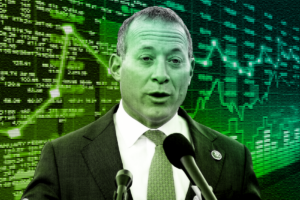We Need To End Government-Granted Patent Monopolies
In the absence of patents, it would be rare that a drug would sell for more than $30 a prescription. (Image: Adobe)
(Image: Adobe)
Last week I saw a somewhat shabbily dressed man in the pharmacy trying to get a COVID booster. They told him it would cost $130. (It was the Moderna booster.) He said that he didn’t have that much money. The pharmacist and a couple of people in line then suggested a few places he may be able to get it at a lower cost or possibly even free. The man left, and I hope he was able to get an affordable shot.
I was reminded of this incident when I read a New York Times piece on pharmacy benefit managers (PBMs). The gist of the piece is that PBMs often engage in sleazy practices that involve squeezing some drug stores, while overcompensating the chains with which they are affiliated. The result is higher prices and lower quality service, as many drug stores go out of business.
Years ago, Ronald Reagan ran around saying that we don’t need government to fix the problem, government is the problem. In the case of the high cost of drugs and vaccines and other pharmaceutical products, Reagan is exactly on the mark. The problems that people face in getting the drugs they need at affordable prices is almost entirely due to government-granted patent monopolies and related protections.
Drugs are almost always cheap to manufacture and distribute.
The point, which I know I make endlessly, is that drugs are almost always cheap to manufacture and distribute. In a free market it would be rare that a drug would sell for more than $30 a prescription — and often for considerably less. We would not have problems paying for our drugs and vaccines if they sold at free-market prices. And there would be no such thing as PBMs in a free market. Do we have “grocery benefit managers”?
Government-granted patent monopolies create this totally avoidable problem where people have to struggle to pay for the drugs they need to protect their health and possibly their life. These can cost tens of thousands or even hundreds of thousands of dollars annually. Even if they are able to get an insurer, the government, or a GoFundMe page to cover the cost, why do we want to make people struggling with serious health issues go through this effort?
Public funding: A better option
The rationale for patent monopolies is that they are necessary for the industry to recoup the research costs involved in developing new drugs or vaccines. If they spent hundreds of millions of dollars developing a drug and generic competitors could start producing it the day it was approved by the Food and Drug Administration, they would have no ability to earn back the money they invested. If this was the situation drug companies faced, they would never invest serious money in developing new drugs. It would not be profitable.
This argument is completely true, but the problem with the logic is that we have other mechanisms for financing the research needed to develop new drugs. We could have public funding. That is not a secret. We currently spend over $50 billion a year to finance biomedical research through the National Institutes of Health and other government agencies.
If we wanted to replace the patent-supported research currently conducted by the pharmaceutical industry, we would need to increase this amount by around $120 billion a year. That may seem like a lot of money, but we would probably save more than $500 billion a year by having all drugs and pharmaceutical products sold in a free market.
If we were to increase government funding enough to replace the patent-supported research done by the industry, we would want a different mechanism. My preferred route, which I discuss in “Rigged” (it’s free) is a system where the government signs long-term contracts (10 to 15 years) with drug companies to support research in specific areas.
For example, a company could contract to get $40 billion to do research for the next 12 years into developing treatments and/or cures for heart disease. Another company may contract to do research on breast cancer or lung cancer. The idea would be that the government would make the initial award and then have a largely hands-off approach, other than periodic audits just to make sure that work is actually being done and the company’s executives have not just run off to Bermuda.
We could have public funding. That is not a secret.
I held up the Defense Department as a model for this sort of contracting. While there are plenty of abuses in military contracting, the fact is that we do get good weapons at the end of the day.
And, we have a huge advantage with biomedical research over military procurement. There are legitimate grounds for secrecy with military research. We don’t want to put the plans for our latest weapon systems on the web where ISIS can download them. There is no basis for similar fears with biomedical research. In fact, we should want research findings shared as broadly as possible, so that researchers around the world can benefit from the latest developments (more on this in a moment).
In fact, we can look to a better example for successful government contracting than straight military research. Former Biden administration economist Ernie Tedeschi pointed me to the example of SpaceX, which has made enormous progress in improving the efficiency of putting objects into space. In spite of the contempt SpaceX’s CEO Elon Musk seems to have toward the government, his accomplishments in this area were done on the government’s dime. It’s reasonable to assume that if a government agency can successfully find an innovative company like SpaceX to develop new rocket systems, a government agency can also find innovative companies to do good research in developing new drugs.
The lack of secrecy should help in this process. In fact, when contracting for the development of new drugs, a condition of getting the money should be that any contractor, as well as all subcontractors (most defense contracts involve many subcontractors), post all their findings on the web as soon as practical.
This will both allow for rapid dissemination, so that other researchers can quickly build on successes and learn from failures, and also limit opportunities for waste and fraud. If a company with a major contract for research in a specific area has nothing to show after six months or a year, it will be very clear to the experts in the field that something is seriously wrong. If there is not a very good story as to why the company does not seem to be making progress, or even have failures to report, then it presumably would lose its contract.
This sort of openness will require some agreement for sharing the costs of research across countries. Some may view this sort of international agreement as impossible, but in fact it is exactly what the United States has been negotiating with the TRIPS provisions of the WTO and numerous other provisions on intellectual property in trade agreements over the last four decades. Working out a deal may prove contentious, but the negotiations over intellectual property issues are already contentious.
There is another very important advantage to open research that is impossible to exaggerate. The patent monopoly financing system gives drug companies an enormous incentive to misrepresent the safety and effectiveness of their drugs. The markups on patent-protected drugs are typically many thousand percent over production costs.
This gives drug companies a huge incentive to push their drugs as widely as possible. The opioid crisis was the most extreme example of this sort of misrepresentation, where drug companies lied about the addictiveness of the new generation of opioids, but the problem arises constantly. The FDA does try to police the industry, and stronger rules on the availability of clinical trial data make deception more difficult, but when a company faces such large gains from lying, it will be difficult to ensure evidence on safety and effectiveness is presented fully and accurately.
We should want research findings shared as broadly as possible.
In a system of open research, where contracts are renewed and expanded based on a big picture assessment of the value of its research quality, there would be little incentive or opportunity to lie in a way that could have adverse health outcomes. Companies will try to put their research in the best possible light. But at worst, any exaggerations would lead to a bad allocation of research funds, where a less effective company got funding in place of one that would be more effective. That’s unfortunate, we want to the money to go where it would be most productive, but that is of much less consequence than treating people with a drug that is ineffective or even harmful.
There is one other important aspect to this mode of direct public funding as an alternative to patent-financed research. There are often nutritional or environmental factors (such as exposure to lead) that have major effects on health outcomes. Under the current system, the pharmaceutical industry has no incentive to examine these possibilities. They are only rewarded for developing a patentable product.
Discovering that processed sugar might increase the frequency of certain types of mental illness is not going to get them any money. They therefore have no incentive to research that sort of issue, and even if their efforts to develop a patentable product might point in this direction, they would have no incentive to share that information.
By contrast, if companies are being awarded contracts based on their record for producing useful research, they would have tremendous incentive to pursue leads suggesting that nutrition, exercise or other factors have a significant impact on health in particular areas. That could lead to a far more integrated approach to public health.
Getting from here to there
I have been around Washington long enough to know that we’re not about to replace the mechanism for financing drug development in one fell swoop. That would look hugely risky from both an economic standpoint — pharmaceuticals is a huge industry — and also a health standpoint. We don’t want to take a risk that many important drugs don’t get developed because we have dynamited our industry.
But it is possible to envision a gradual path where we demonstrate the effectiveness of the direct funding model in two or three areas. This could mean some additional allocation of funding to NIH with the idea that it would go to directly supporting the development and testing of new drugs, which would then be available as generics from the day they are approved.
For example, we could allocate $30 billion over the next decade to support the development of new drugs to treat specific type of cancer or diabetes. That would not prevent the industry from pursuing patent-supported research in the same area. The companies would just face the risk that if they did develop a new drug that it may be competing with one that is every bit as effective and selling for less than one-tenth of the price. Of course, if the industry is confident that government-funded research will only lead to dead ends, they need not fear that risk.
Drugs are cheap, but government-granted patent monopolies make them expensive.
There is already a proof of concept that we can point to. Peter Hotez and Maria Elena Bottazzi, along with their colleagues at Baylor College of Medicine and Texas Children’s Hospital, developed a COVID vaccine, Corbevax. That vaccine has been administered to more than 100 million people in India and Indonesia, protecting them against serious illness and death from COVID.
Corbevax was developed on an open-source model. That means the process for producing the vaccine, as well as the data on safety and effectiveness, is entirely open and available to anyone. Anyone in the world with the necessary manufacturing facilities can produce the vaccine. As a result, the vaccine is cheap, selling for around $2.50 a dose in India and Indonesia.
It would be desirable to have the Corbevax vaccine available in the United States. While it would probably cost more here, due to higher costs for labor and other items, we’re probably talking around $5 a shot. That compares to the $130 for the Moderna booster that my pharmacy was going to charge the shabbily dressed man. (Most people don’t see this price tag, since insurers or the government are picking up much or all of the tab for the boosters, but we do ultimately pay this cost through one pocket or another.)
It would be a great first step if the FDA would approve Corbevax for distribution in the United States. In addition to saving billions of dollars paying for boosters and making them universally assessable, it would help to make the basic point: Drugs are cheap, but government-granted patent monopolies make them expensive. Once people fully appreciate that fact, we can have more intelligent discussions of the best mechanism for financing research.
Your support matters…Independent journalism is under threat and overshadowed by heavily funded mainstream media.
You can help level the playing field. Become a member.
Your tax-deductible contribution keeps us digging beneath the headlines to give you thought-provoking, investigative reporting and analysis that unearths what's really happening- without compromise.
Give today to support our courageous, independent journalists.








You need to be a supporter to comment.
There are currently no responses to this article.
Be the first to respond.